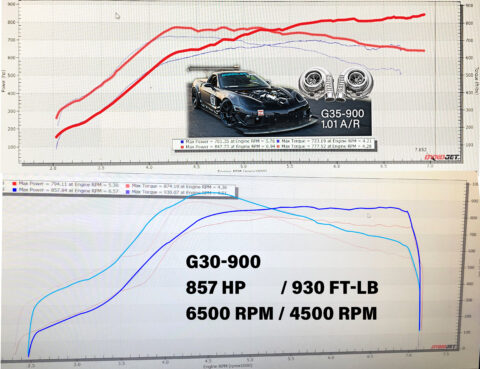Learn More About The Best Turbo Combinations For Your LS Engine
LS Engine Performance Data
The LS engine is one of the most popular modern engine platforms for today’s turbocharger enthusiast. The stout construction, plethora of aftermarket parts support, and availability has made this the go-to V8 engine for turbocharging. From bone stock to fire breathing combinations, this page will give you tips and dyno performance data from some of the top racers and influencers using the LS engine as a power plant. The data below will help you identify the best turbo for an LS engine. Please note, the performance data below has been provided by race teams that are using Garrett turbochargers and is intended to be used as reference data when identifying a turbo match for an LS engine. Performance results will vary unless all conditions are identical.
5 Tips For Turbocharging Your LS Engine
Shane Whalley is a top fabricator and drifter who uses LS engines in all of his vehicle builds. Here he gives you his top 5 tips when turbocharging an LS engine.
1. Crankcase ventilation
2. Knowing your ring gap
3. Turbo selection (of course a Garrett is the right choice)
4. Know your engine specs
5. Exhaust routing and sizing
Twin Turbo or Single Turbo LS Engine Data
in this write up is a dyno graph comparison between a single Garrett GTX4202R turbo and twin GTX3582R Gen II turbos on the same 5.3L LS engine with an 800 horsepower tune. Both of the turbocharger setups are capable of making more power, and they both have, but for an accurate comparison we are looking at the “race tune” used by for Formula Drift Pro 2 racer, Jonathan Hurst.
The single turbo setup has a GTX4202R turbocharger with a 76mm compressor and 82mm turbine wheel and a 1.01 divided T4 turbine housing. The twin turbo configuration has two GTX3582R Gen II turbo chargers with 66mm compressor and 68mm turbine wheels and 1.01 V-band turbine housings. The GTX3582R turbochargers are are available in standard and reverse rotation options for perfect mirrored symmetry as seen in the images of Jonathan’s engine compartment.
Looking at the dyno graph below you can see the comparison between the two setups. Both reached or close to the horsepower target of 800 however the larger GTX4202R made it 300 RPM sooner. Looking at the torque numbers you can see the larger turbo made 78 FT-LB more peak torque and made it 600 RPM earlier. The other interesting thing to point out when looking at the torque numbers is how the torque curves compare throughout the entire dyno pull. Starting at 3500 RPM the single turbo (light blue) makes roughly 50 LB-FT of torque more, once it gets to 4000 RPM it’s close to 100 LB-FT more and at 4500 RPM the single turbo setup is making about 150 LB-FT of torque more than the twin setup.
Read the entire article here: READ MORE HERE
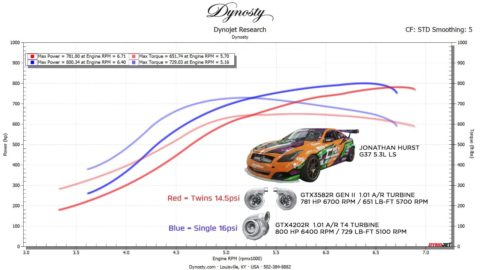
LS Powered S550 Mustang!
Being a turbo engine guru, Shane has always been a huge turbo fan since he first got into cars. “From the way the power comes on, to the sound they make, a huge benefit to a turbo is the ease of adding power. No need to change out nitrous jets, swap pulleys, or ever worry about throwing a belt off. The power is always there, and can be turned up with the turn of a knob, or click of a button,” says Whalley. For this build he chose a single Garrett GTX4508R because it supports up to 8.0L engines and can make up to 1250 horsepower. By using the Garrett Boost Adviser matching program you can see why the GTX4508R is a good match for a 1000 horsepower 5.7L engine by looking at the two redlines on the compressor map. The line on the right represents max power and it falls in the most efficient part of the compressor map producing cooler air than other parts of the map helping to increase the volumetric efficiency of the engine.
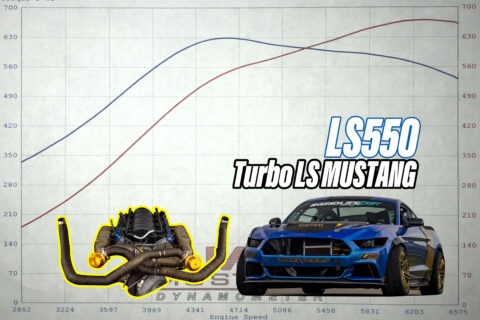
Cash Racing Does It Again: 1000 HP With The Garrett G42-1200 Turbo
Drifting is all about power, control, and response and racers are always looking for ways to improve these inputs. Jonathan Hurst is a successful drifter and has navigated his way from amateaur to professional racer in the popular Formula Drift Series. He has used several combinations of Garrett turbochargers over the years and is now using the new G Series G42-1200 turbo in a single configuration with the 1.01 A/R V-Band turbine housing. His LS engine just hit the dyno and made 1003 wheel horsepower and 909 LB-FT of torque! Very impressive numbers and that’s with peak torque at 4500 RPM and peak power at about 6200 RPM.
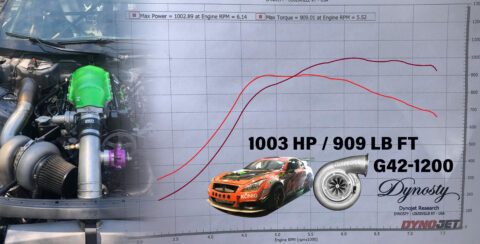
Feras Qartoumy Record Setting Twin Turbocharged LS7 Powered C6 Corvette
With Feras’ engine being 430 cubic inches or 7 liters, we decided the new Garrett G35-900 would be the best match for this twin turbo beast. The G Series turbochargers can be ordered in standard and reverse rotation or “mirrored turbos” as some call them. This means there is one turbo for the left side of the engine and one for the right side of the engine. A great option when fabricating symmetrical charge piping throughout the engine bay as it can help deliver consistent exhaust energy to both turbos. With some trimming of the lower half of the front fenders, the G35-900 turbos with V-band 1.01 A/R housings sit perfectly in the wheel wells just behind the front tires.
The G35-900 twin turbos performed very well making 1104 wheel horsepower at 6200 RPM and 1030 FT-LB of torque at 5500 RPM. Very impressive however this is not the power at which the car runs on track and is tuned down to a safer 850 HP / 777 ft-lb combination as seen in the top dynograph. The G Series product line is very unique in sizing that the G30-770, G30-900, G35-900 can be interchanged directly to allow for multiple levels of stage performance upgrades. In the next example, you will see how the G30-900 performed on the same Corvette.
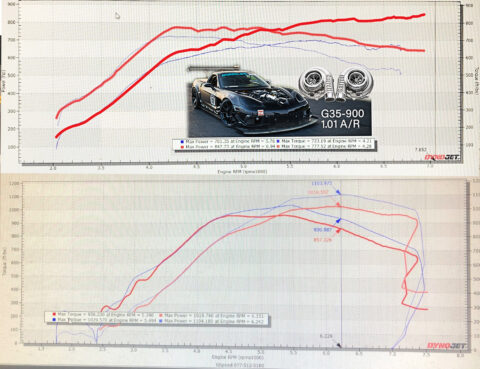
C6 LS7 Twin Turbo Corvette Tests The G30-900 Turbochargers
As mentioned above, Feras Qartoumy has an extremely fast C6 Corvette used primarillary for Global Time Attack and Grid Life Events but he does also take it to the occasional AutoCross event. With Auto Cross, the track is shorter, turns are tighter, and response time can either win or lose your race. We wanted to see how the G30-900 would perform on this LS7 powered Corvette. Ideally, the smaller compressor stage and smaller turbine housing size should shift the power band to the left, increasing boost response.
One should be careful when doing this because smaller A/R turbine housings will cause higher back pressure at high engine RPM. Additionally, using a smaller compressor stage can improve response but it also means the turbo must spin a little faster to make the same flow (potential power) as the larger compressor wheel. Let’s look at the dynograph to see how the G30-900 performed.
You can see in the lower graph how much quicker the turbo comes in and how steep the curve jumps up at 2500 RPM, this continues up until it hits peak torque at 4500 RPM. The horsepower curve is step and peaks around 4500 RPM then carries through the run at 7000 RPM. Here you can see the G30-900 was able to produce the same power as the G35-900, only much sooner and providing the improved response Feras was looking for. One other thing to note is it took 6 more PSI from the turbos to make that power so just remember there will always be a trade off when plus or minus sizing turbos.
